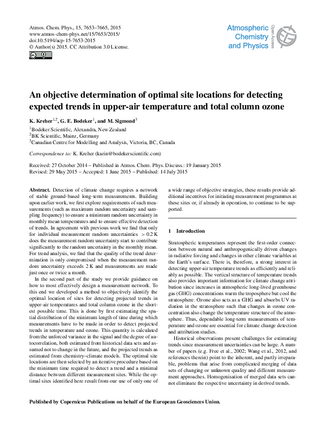Title
An objective determination of optimal site locations for detecting expected trends in upper-air temperature and total column ozone
Authors
Kreher, K., Bodeker, G. E., and Sigmond, M.
Published
by Atmospheric Chemistry and Physics (ACP) at 2015-07-14
Abstract
Detection of climate change requires a network of stable ground-based long-term measurements. Building upon earlier work, we first explore requirements of such measurements (such as maximum random uncertainty and sampling frequency) to ensure a minimum random uncertainty in monthly mean temperatures and to ensure effective detection of trends. In agreement with previous work we find that only for individual measurement random uncertainties > 0.2 K does the measurement random uncertainty start to contribute significantly to the random uncertainty in the monthly mean. For trend analysis, we find that the quality of the trend determination is only compromised when the measurement random uncertainty exceeds 2 K and measurements are made just once or twice a month.
In the second part of the study we provide guidance on how to most effectively design a measurement network. To this end we developed a method to objectively identify the optimal location of sites for detecting projected trends in upper-air temperatures and total column ozone in the shortest possible time. This is done by first estimating the spatial distribution of the minimum length of time during which measurements have to be made in order to detect projected trends in temperature and ozone. This quantity is calculated from the unforced variance in the signal and the degree of autocorrelation, both estimated from historical data sets and assumed not to change in the future, and the projected trends as estimated from chemistry–climate models. The optimal site locations are then selected by an iterative procedure based on the minimum time required to detect a trend and a minimal distance between different measurement sites. While the optimal sites identified here result from our use of only one of a wide range of objective strategies, these results provide additional incentives for initiating measurement programmes at these sites or, if already in operation, to continue to be supported.
Citation
Kreher, K., Bodeker, G. E., and Sigmond, M.: An objective determination of optimal site locations for detecting expected trends in upper-air temperature and total column ozone, Atmos. Chem. Phys., 15, 7653-7665, https://doi.org/10.5194/acp-15-7653-2015, 2015.
